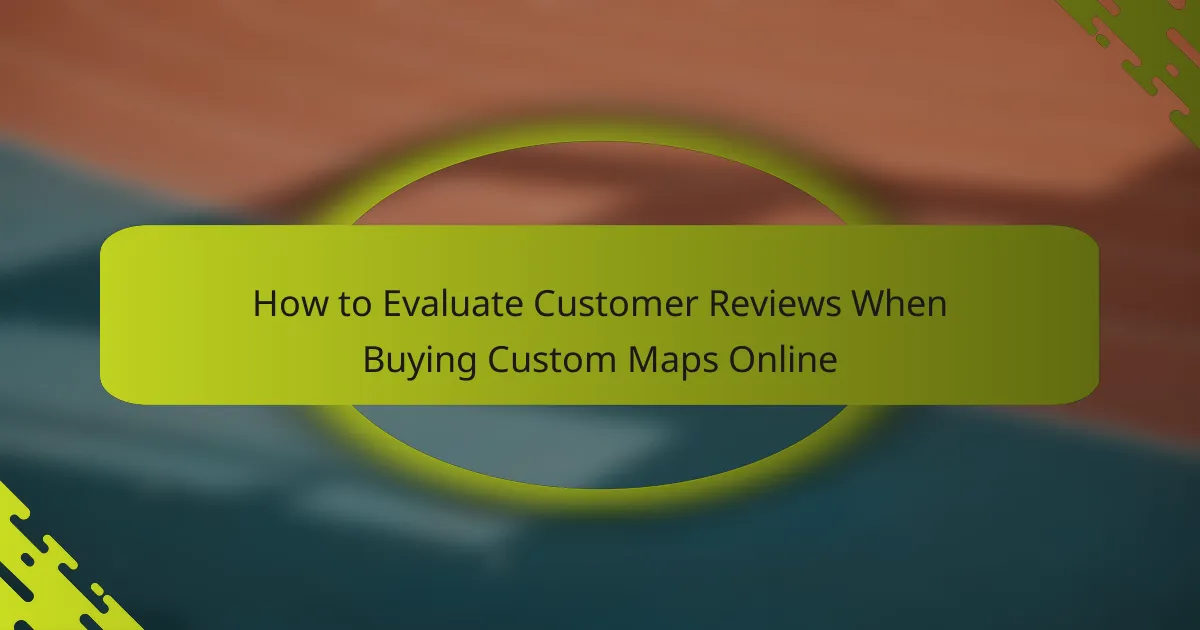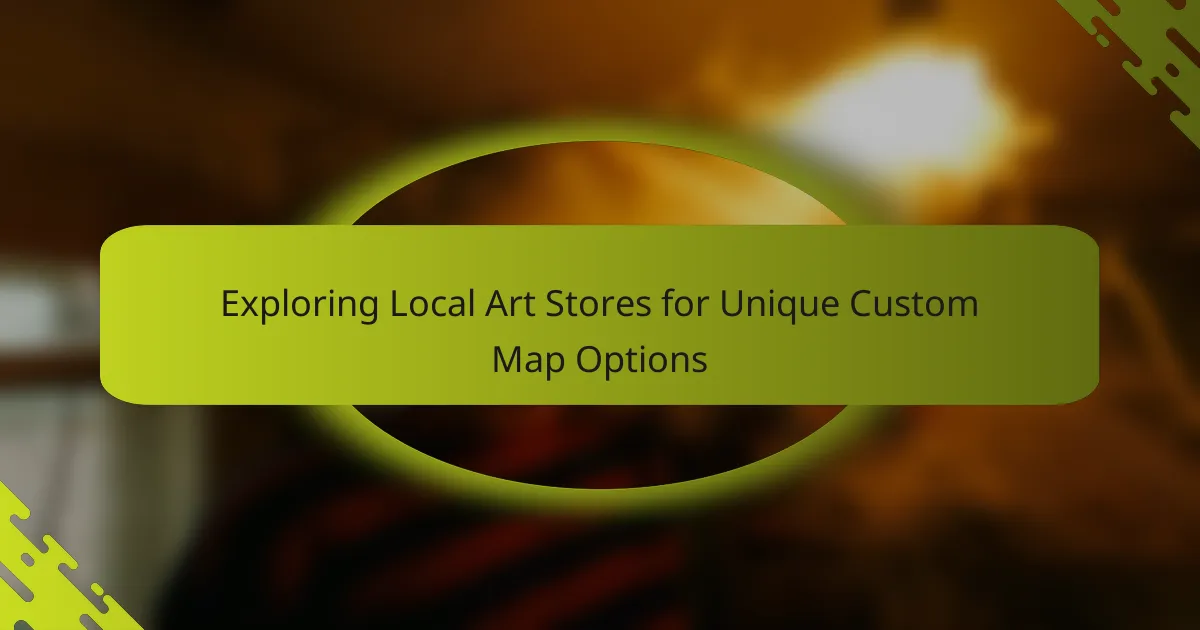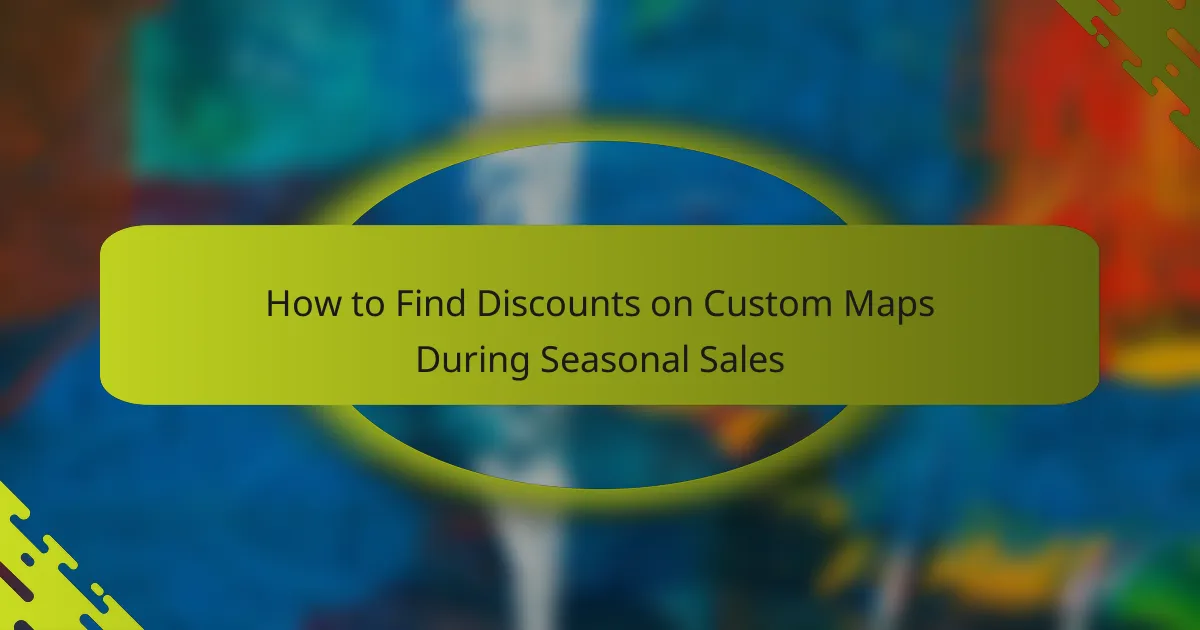When purchasing custom maps online, evaluating customer reviews is crucial for making an informed decision. By focusing on indicators of authenticity, detailed feedback, and the reviewer’s background, you can assess the credibility of the reviews. Additionally, considering factors such as customization options, material quality, and delivery details will enhance your overall satisfaction with the purchase.
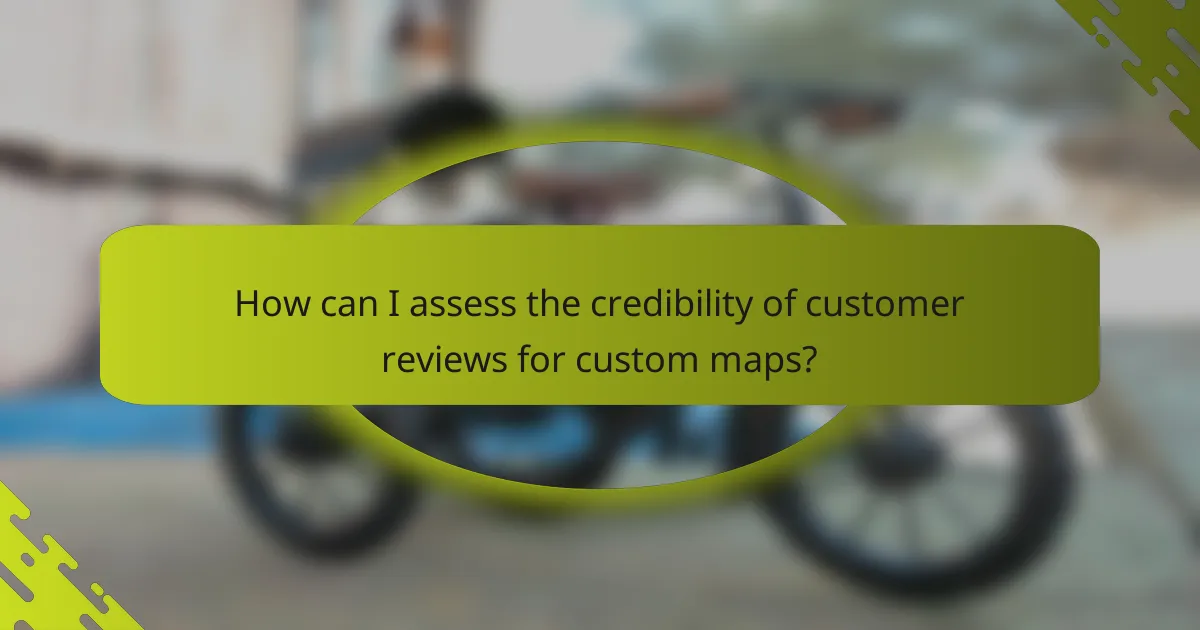
How can I assess the credibility of customer reviews for custom maps?
To assess the credibility of customer reviews for custom maps, focus on indicators of authenticity, the detail in feedback, and the reviewer’s background. This approach helps ensure you are making informed decisions based on reliable information.
Look for verified purchase indicators
Verified purchase indicators are essential for determining if a review is genuine. Look for badges or labels that confirm the reviewer actually bought the custom map from the seller. These indicators can significantly enhance the reliability of the feedback you are considering.
Many platforms display these indicators prominently, so check for them before diving into the content of the reviews. If a review lacks this verification, treat it with caution.
Check for detailed and specific feedback
Detailed and specific feedback is a strong sign of a credible review. Look for comments that mention particular features of the custom map, such as the quality of materials, accuracy of details, or customer service experiences. Vague reviews often lack credibility.
For instance, a review stating “the map was nice” is less helpful than one that describes “the colors were vibrant, and the landmarks were accurately placed.” Specifics can help you gauge whether the product meets your needs.
Evaluate the reviewer’s profile and history
Examining the reviewer’s profile and history can provide insights into their credibility. Check how many reviews they have written, their overall ratings, and their engagement with other products. A reviewer with a consistent history of detailed reviews is generally more trustworthy.
If possible, look for reviews from users who have purchased similar custom maps. Their experiences can offer valuable context and help you make a more informed choice. Avoid relying solely on reviews from users with little to no history, as their feedback may not be as reliable.

What are the key features to consider in custom maps?
When buying custom maps online, key features to consider include customization options, the quality of materials used, and delivery and shipping details. These factors significantly impact the overall value and satisfaction of your purchase.
Customization options available
Customization options for maps can vary widely, including choices for size, color schemes, and specific landmarks or routes. Some providers allow you to add personal touches, such as names or messages, which can enhance the map’s significance.
When evaluating customization, check if the service offers digital previews before finalizing your order. This can help you visualize the final product and make necessary adjustments.
Quality of materials used
The quality of materials used in custom maps is crucial for durability and aesthetics. Look for maps printed on high-quality paper or canvas, as these materials tend to last longer and resist wear and tear.
Additionally, consider whether the map is laminated or treated for water resistance, especially if it will be displayed in high-traffic areas or outdoors. Reading customer reviews can provide insights into the longevity of the materials used.
Delivery and shipping details
Delivery and shipping details can greatly affect your buying experience. Check the estimated delivery times, as they can range from a few days to several weeks depending on the provider and your location.
Also, review the shipping costs and policies regarding returns or exchanges. Some companies may offer free shipping for orders over a certain amount, which can be a deciding factor in your purchase.
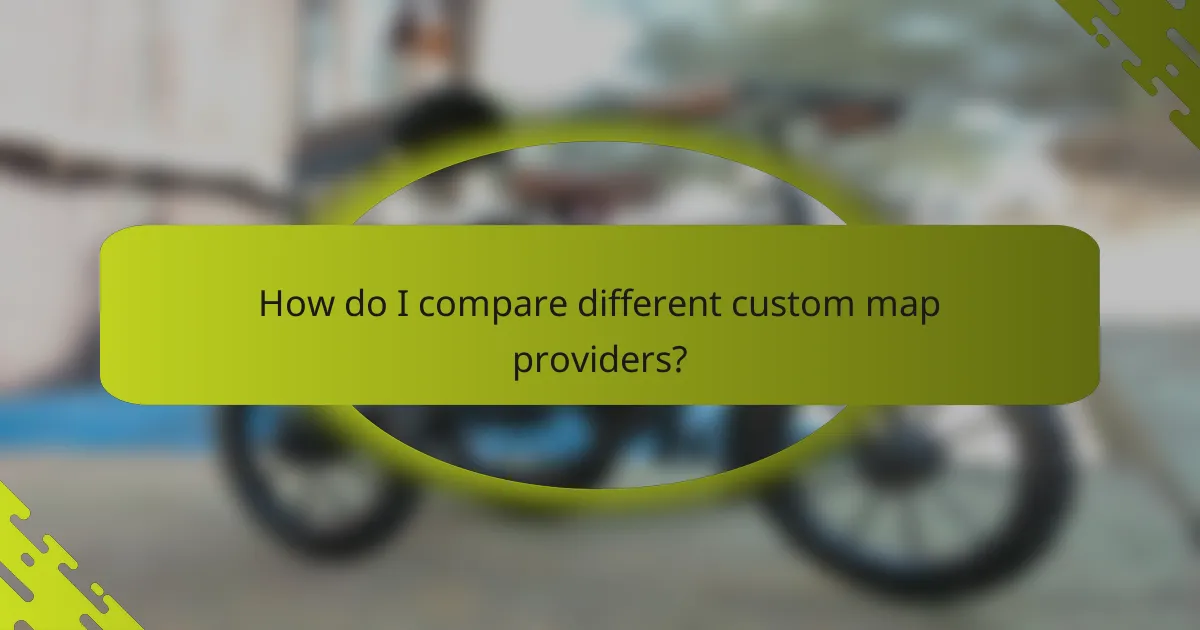
How do I compare different custom map providers?
To compare different custom map providers effectively, focus on customer reviews, pricing options, and return policies. Evaluating these aspects will help you make an informed decision that aligns with your needs and budget.
Review customer ratings and testimonials
Start by checking customer ratings and testimonials to gauge overall satisfaction with each provider. Look for platforms that aggregate reviews, as they often provide a broader perspective on the quality of the maps and service.
Pay attention to both positive and negative feedback. High ratings are a good sign, but read through testimonials to understand specific strengths or weaknesses, such as map accuracy or customer service responsiveness.
Analyze pricing structures and packages
Compare the pricing structures and packages offered by different custom map providers. Some may offer basic maps at lower prices, while others provide premium options with additional features like customization or framing.
Consider what is included in each package, such as shipping costs or digital versions. A detailed comparison can help you identify the best value for your budget, typically ranging from $50 to several hundred dollars depending on complexity and size.
Examine return and refund policies
Review the return and refund policies of each provider to understand your options if the map does not meet your expectations. A flexible return policy can provide peace of mind, especially for custom products.
Look for providers that offer a satisfaction guarantee or a reasonable timeframe for returns, typically around 30 days. This ensures you can return the map if it does not match your specifications or quality standards.
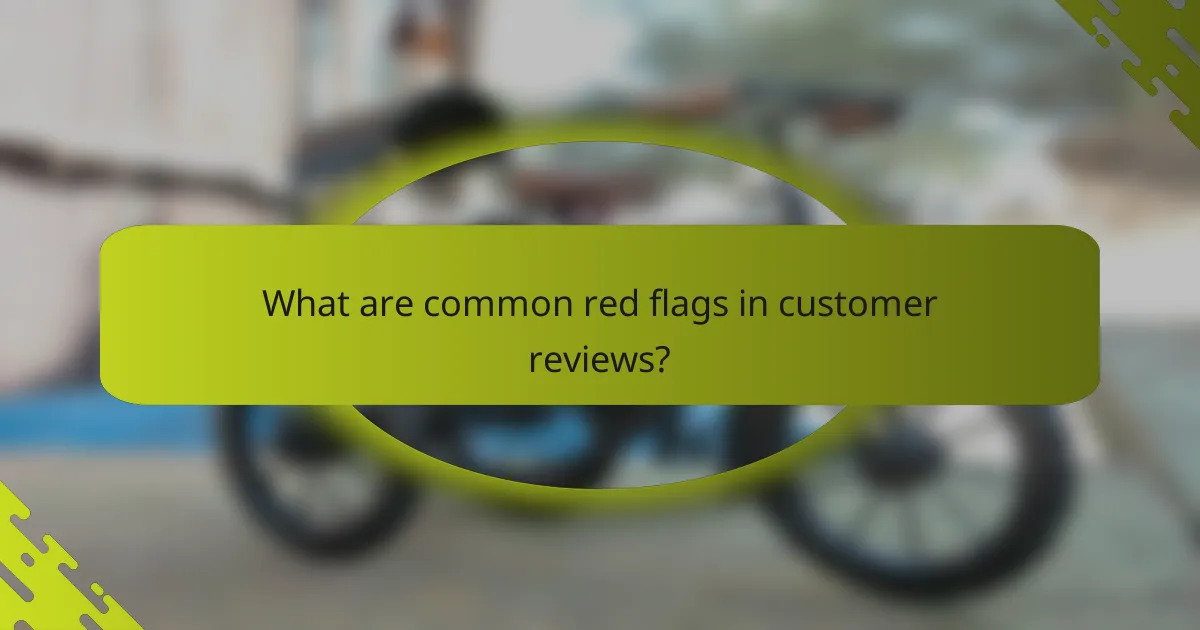
What are common red flags in customer reviews?
Common red flags in customer reviews include inconsistent feedback across different platforms, overly generic comments, and a high volume of negative reviews. Identifying these issues can help you gauge the reliability of the feedback and the quality of the custom maps you are considering purchasing.
Inconsistent feedback across platforms
When reviews vary significantly across different websites, it raises questions about their authenticity. For instance, if a custom map has glowing reviews on one site but mixed or negative feedback on another, it may indicate that some reviews are fabricated or biased. Look for patterns in the feedback to determine which comments are consistent and trustworthy.
To evaluate this, check multiple review sites such as Trustpilot, Google Reviews, and social media platforms. If a product consistently receives poor ratings on most platforms, it’s a strong indicator to reconsider your purchase.
Overly generic or vague comments
Reviews that lack specific details about the product can be a warning sign. Phrases like “great quality” or “didn’t like it” without further explanation do not provide useful insights into the product’s features or performance. Genuine reviews typically include specifics about the map’s accuracy, design, or usability.
When reading reviews, look for comments that discuss particular aspects of the custom map, such as the clarity of details or the quality of materials used. This information is more likely to reflect the actual experience of the buyer.
High volume of negative reviews
A significant number of negative reviews can indicate systemic issues with the product or the seller. If you notice that many customers report similar problems, such as poor customer service or inaccurate maps, it’s wise to take these concerns seriously. A few negative reviews among many positive ones may be acceptable, but a trend of dissatisfaction should raise alarms.
Consider the ratio of negative to positive reviews. A product with a high percentage of negative feedback (for example, more than 20% of reviews being negative) may not be worth the risk. Always prioritize products with a strong overall rating and a majority of positive experiences.

How can I leverage social media for insights on custom maps?
Social media platforms are valuable tools for gathering insights on custom maps. By monitoring discussions and user-generated content, you can gain a better understanding of customer preferences and experiences.
Follow relevant hashtags and discussions
Tracking specific hashtags related to custom maps can reveal trends and user sentiments. Look for tags like #CustomMaps, #MapArt, or #PersonalizedMaps to find posts that showcase customer experiences and feedback.
Engaging with these discussions allows you to see real-time reactions to products. Pay attention to comments and interactions, as they can highlight common issues or praises that may influence your buying decision.
Engage with customer communities
Joining online communities focused on cartography or custom maps can provide deeper insights. Platforms like Facebook groups or Reddit forums often have dedicated spaces where users share their experiences and recommendations.
Participating in these communities not only helps you gather information but also allows you to ask questions directly. This interaction can lead to valuable advice and tips from experienced users, enhancing your understanding of what to look for in custom maps.

What are the latest trends in custom map design?
The latest trends in custom map design focus on enhancing user experience through innovative technology and personalized content. Key developments include the integration of augmented reality features and the rise of user-generated content for greater customization.
Incorporation of augmented reality features
Augmented reality (AR) is becoming a significant trend in custom map design, allowing users to interact with maps in a dynamic way. By overlaying digital information onto the physical world, AR enhances navigation and exploration, making maps more engaging.
For example, a custom map app might allow users to point their device at a location and see historical data or points of interest pop up in real-time. This feature can be particularly useful for tourism, education, and event planning.
Personalization through user-generated content
Personalization is increasingly driven by user-generated content, enabling individuals to create and share their own map experiences. This trend allows users to add personal notes, images, and recommendations, making maps more relevant to their specific interests.
Platforms that encourage user contributions often see richer content and a more engaged community. For instance, a custom hiking map might include trails marked by users, along with their personal reviews and tips, enhancing the overall value for other hikers.
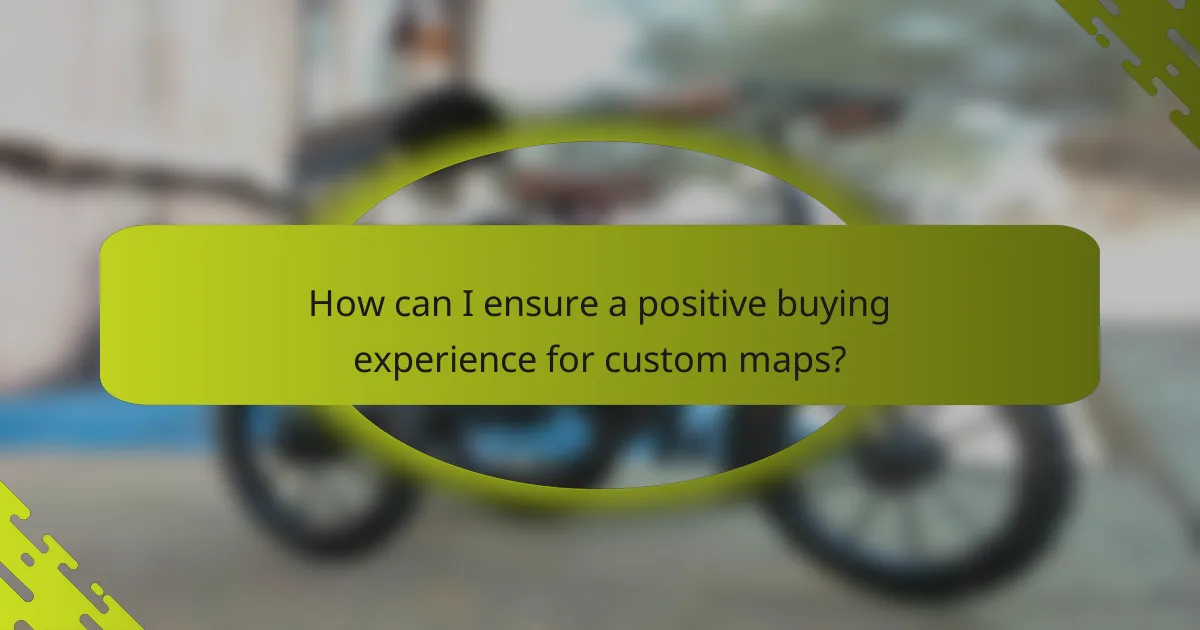
How can I ensure a positive buying experience for custom maps?
To ensure a positive buying experience for custom maps, carefully evaluate customer reviews and seller credibility. Look for detailed feedback on product quality, customer service, and delivery times to make an informed decision.
What should I look for in customer reviews?
When evaluating customer reviews for custom maps, focus on specific details such as the accuracy of the maps, the quality of materials used, and the overall satisfaction of previous buyers. Reviews that mention the clarity of the map design and the responsiveness of customer service are particularly valuable.
Pay attention to the number of reviews and the overall rating. A product with a high number of positive reviews is generally more reliable than one with only a few reviews, even if those are positive.
How can I assess the credibility of the seller?
To assess the credibility of a seller offering custom maps, check their ratings on the platform you are using. Look for sellers with a consistent track record of positive feedback and a history of fulfilling orders promptly.
Additionally, verify if the seller provides clear contact information and a return policy. A transparent seller is more likely to offer a satisfactory buying experience.
What are common red flags in reviews?
Common red flags in reviews include repeated complaints about poor quality, long shipping times, or unresponsive customer service. If multiple reviews mention similar issues, it’s wise to consider alternative sellers.
Be cautious of overly positive reviews that lack detail, as they may be fabricated. Genuine reviews typically provide insights into both the strengths and weaknesses of the product.
How can I use reviews to negotiate or ask questions?
Use insights from reviews to formulate specific questions for the seller before making a purchase. For example, if reviews mention issues with map clarity, ask the seller about their quality assurance process.
Additionally, if you notice a common complaint about delivery times, inquire about shipping options and estimated arrival dates. This proactive approach can help you gauge the seller’s responsiveness and willingness to address concerns.






